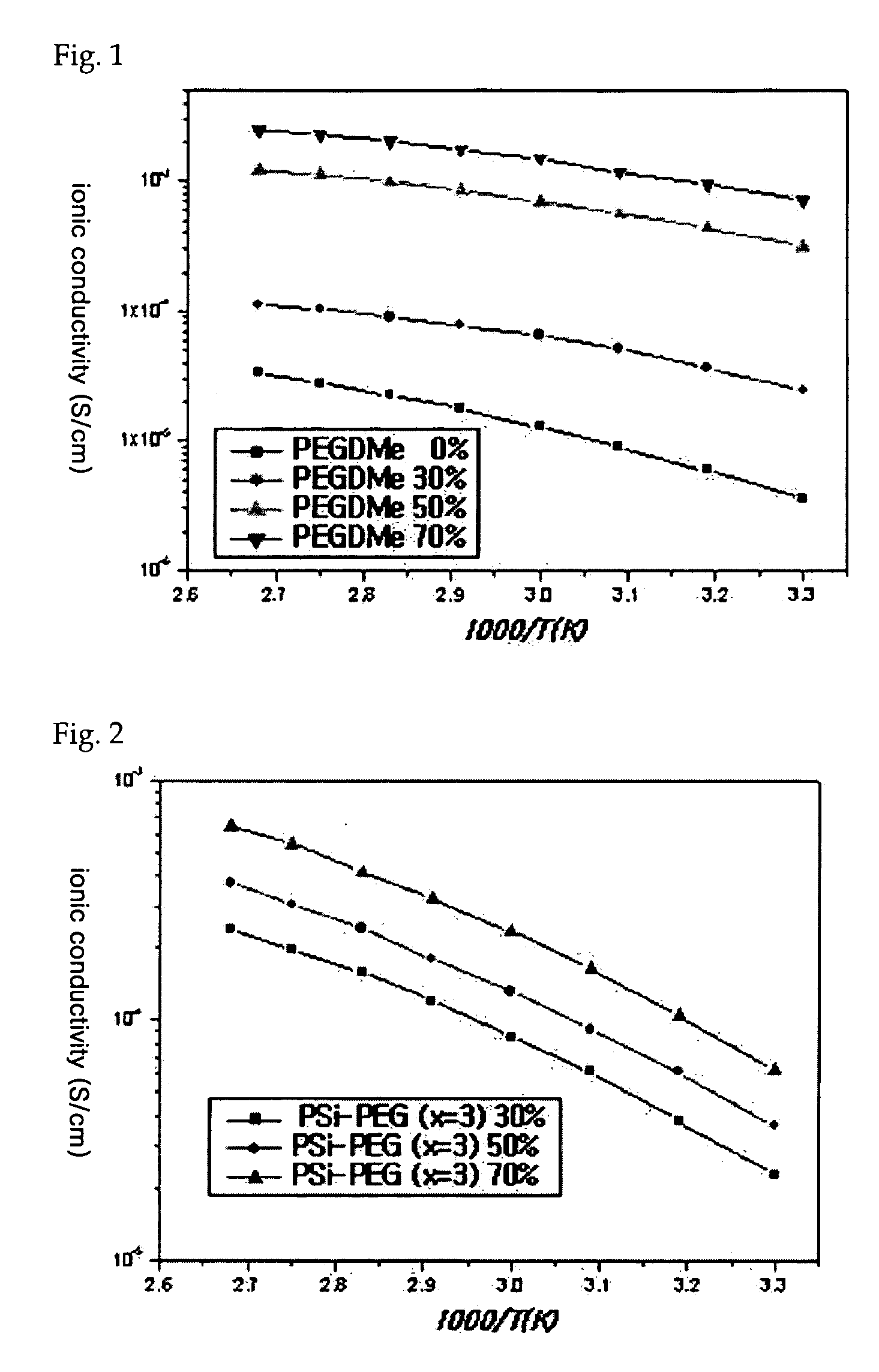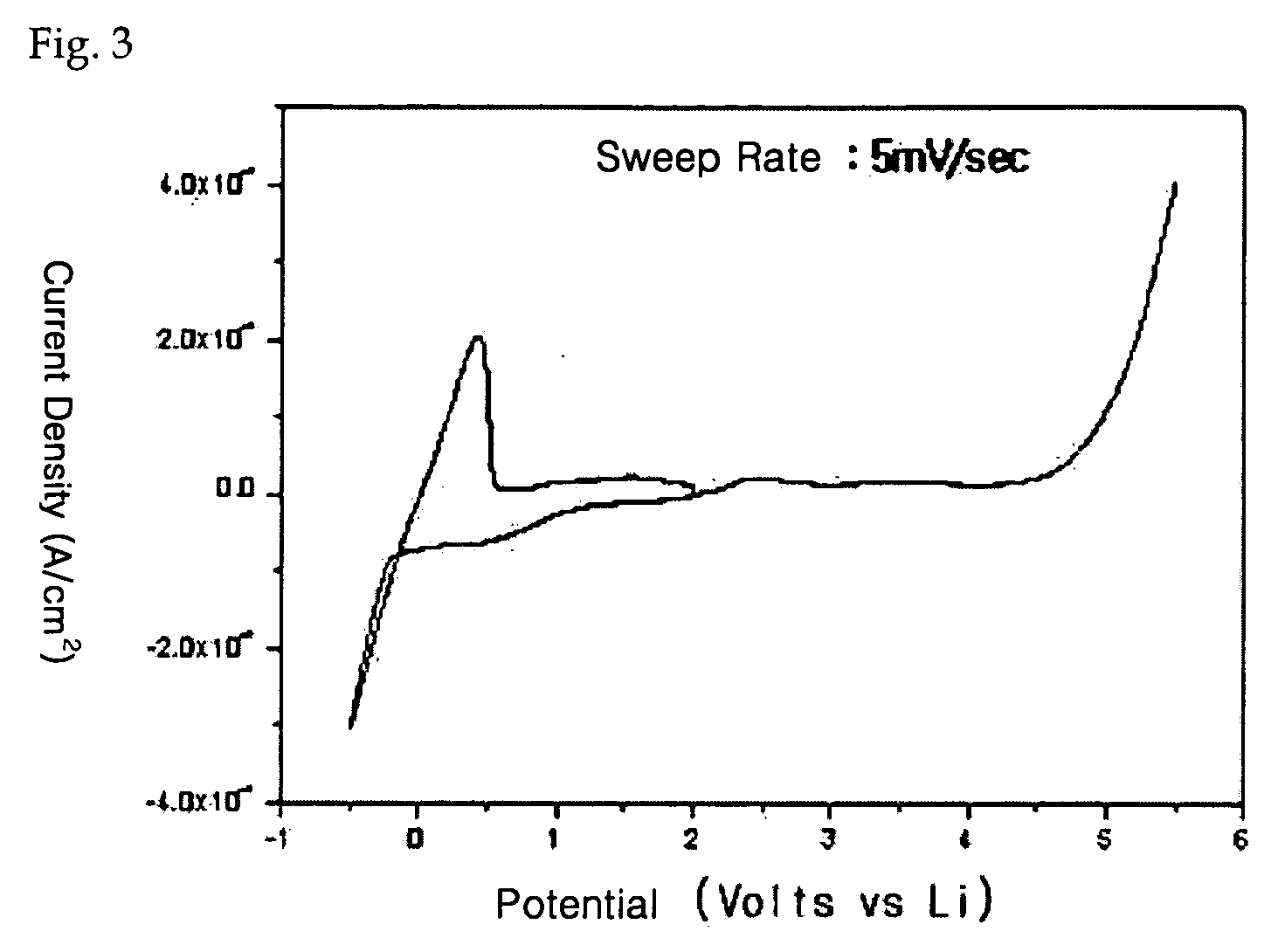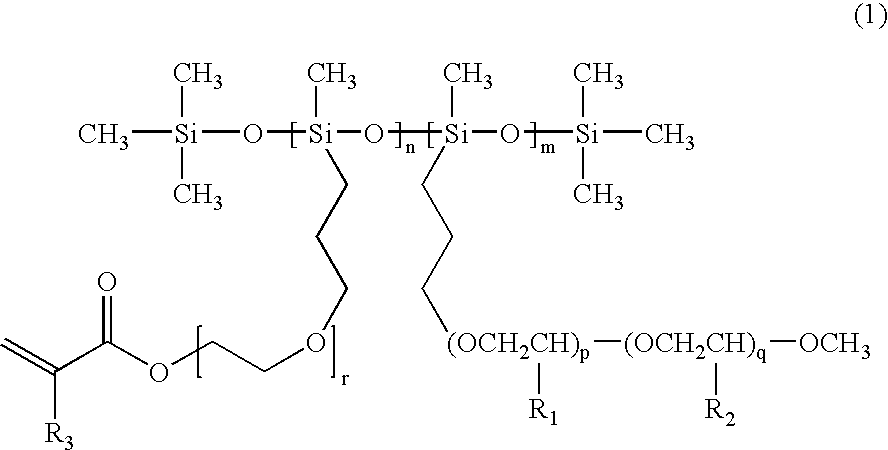Polysiloxane-based compound and solid polymer electrolyte composition using the same
a technology of polysiloxane and compound, which is applied in the direction of non-aqueous electrolyte cells, cell components, non-metal conductors, etc., can solve the problems of poor mechanical properties, poor mechanical properties when formed in films, and inability to apply for operation at room temperature, and achieves easy cross-linking
- Summary
- Abstract
- Description
- Claims
- Application Information
AI Technical Summary
Benefits of technology
Problems solved by technology
Method used
Image
Examples
preparation example 1
Synthesis of Tetramethyl tetra(polethyleneoxide)cyclotetrasiloxane (D4-PEGMP)
[0058]
[0059] To a 1,000 mL three-necked flask equipped with a stirrer, a thermometer, and a dropping funnel, 550 mL of THF dried with Na, 9.6 g of NaOH (0.2 mol) and 32.84 g (0.2 mol) of tri(ethyleneglycol) monomethyl ether(TEGMe, Mw=164.2) were added and then dropwisely added with an excessive amount of allylbromide [29.04 g (0.2 mol)] and the refluxed for 12 hrs under nitrogen atmosphere.
[0060] Upon completion of the reaction, the remaining NaOH and thus obtained NaBr were filtered out and then THF was removed under reduced pressure. The residual reactant was dissolved in chloroform or methylene chloride and then extracted 3 times with 5 wt. % NaOH aqueous solution and the organic layer was dried using MgSO4 and then further dried under vacuum to obtain 30 g of tri(ethyleneglycol) monomethyl monoallylether (TEGM164Ae (x=3), Mw=204.27) (Yield: 73%).
[0061]1H-NMR(300 MHz, CDCl3): ppm 3.37(s, 3H), 3.54-3.6...
preparation example 2
Synthesis of Tetramethyl tetra(ethoxyarylate)cyclotetrasiloxane (D4A) Monomer
[0068]
[0069] In a three-necked flask, 2,4,6,8-tetramethyl cyclotetrasiloxane(D4H) (10 g, 0.0426 mol) was dissolved in 100 mL of toluene, added with Pt(0) catalyst and then dropwisely added with allyloxyethanol(AOE, 18.68 g, 0.17 mol) after dissolving it in 150 mL of toluene. The mixture was refluxed for 12 hrs under nitrogen atmosphere. It was then cooled down to room temperature, stirred after adding active carbon, filtered and evaporated under reduced pressure to obtain about 24 g of D4-2,4,6,8-tetra(ethoxyethanol) (D40E) (Yield: 90%).
[0070]1H-NMR (300 MHz, CDCl3): ppm 0.00(s, 3H), 0.39-0.43(m, 2H), 1.50-1.62(m, 2H), 2.6(s, 1H), 3.31-3.47(m, 4H), 3.65(d, 2H)
[0071] In a three-necked flask, the above D40E (6 g, 0.00925 mol) and triethylamine (4.5 g, 0.037 mol) were dissolved in 100 mL of CHCl3 and then stirred at 0° C. while dropwisely adding acryloyl chloride (4 g, 0.037 mol) after dissolving it in 100 ...
preparation example 3
Synthesis of Poly[methyl(polyethylene oxide)siloxane] (PSi-g-PEG)
[0073]
[0074] In a three-necked flask, polyhydromethylsiloxane(PHMS) (5 g, 0.002934 mol) was dissolved in 100 mL of toluene, added with Pt(0) catalyst and then dropwisely added with tri(ethyleneglycol) monomethyl monoallylether (TEGM164Ae) (17 g, 0.103 mol) after dissolving it in 150 mL of toluene. The mixture was refluxed at 115° C. for 12 hrs under nitrogen atmosphere. It was then cooled down to room temperature, stirred after adding active carbon, filtered and evaporated under reduced pressure to obtain about 17 g of polymethyl(polyalkyleneoxide) siloxane (PSi-g-PEG, x=3) (Yield: 90%).
[0075]1H-NMR(300 MHz, CDCl3): ppm 0.00(s, 28H), 0.39-0.43(m, 13H), 1.50-1.62(m, 13H), 3.31-3.60(m, 12OH).
[0076] In the same way as above, 5 g of PHMS and 30 g of PEGM350Ae were reacted and 25 g of poly[methyl(polyethyleneoxide)siloxane] (PSi-g-PEG, x=7.2) was obtained (Yield: 80.0%).
[0077]1H-NMR(300 MHz, CDCl3): ppm 0.00(s, 36H), 0....
PUM
| Property | Measurement | Unit |
|---|---|---|
| Fraction | aaaaa | aaaaa |
| Length | aaaaa | aaaaa |
| Length | aaaaa | aaaaa |
Abstract
Description
Claims
Application Information
 Login to View More
Login to View More - R&D
- Intellectual Property
- Life Sciences
- Materials
- Tech Scout
- Unparalleled Data Quality
- Higher Quality Content
- 60% Fewer Hallucinations
Browse by: Latest US Patents, China's latest patents, Technical Efficacy Thesaurus, Application Domain, Technology Topic, Popular Technical Reports.
© 2025 PatSnap. All rights reserved.Legal|Privacy policy|Modern Slavery Act Transparency Statement|Sitemap|About US| Contact US: help@patsnap.com



